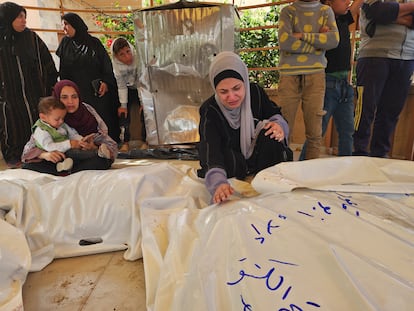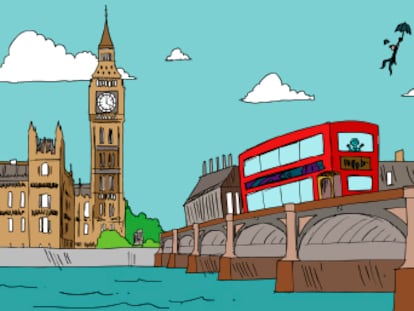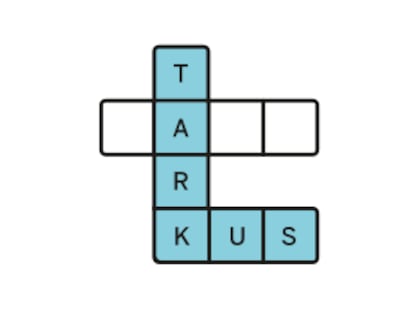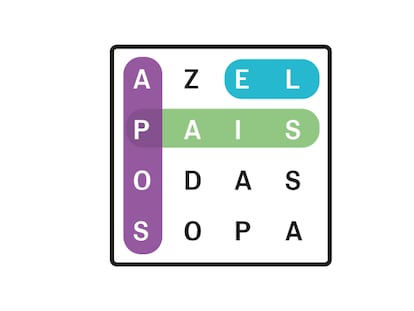Israel deals yet another blow to Gaza’s decimated healthcare system
Nearly all hospitals have been damaged, with less than half partially operational. The latest to be bombed was Al Ahli, while medical supplies are running out due to Netanyahu’s decision to block their delivery

Since Sunday, Al Ahli Hospital has joined the long list of medical centers in Gaza whose storming or bombing by the Israeli army has become — through sheer repetition — a footnote to the war that began in October 2023. Since then, up to January, the UN-affiliated World Health Organization (WHO) has counted more than 654 attacks on healthcare facilities. Of the 36 hospitals in Gaza, virtually all are damaged or have been partially destroyed. Just under half are operating partially, converted into a sort of field hospital that is constantly receiving wounded, virtually without specialized services, and once again undergoing stockpiling due to the decision by Benjamin Netanyahu’s government on March 2 to block all entry into Gaza of goods such as food, water, and medical supplies.
Israeli military authorities gave the residents of Al Ahli, in Gaza City, 20 minutes to evacuate. They then destroyed the emergency department, the laboratory, X-ray equipment, and the pharmacy, claiming — without providing evidence — that it housed “a command and control center used by Hamas.” The missiles caused no deaths, given the prior evacuation, but one child died after being deprived of access to the oxygen he needed. He was one of 40 critically ill patients who “should not have been moved,” as WHO Director-General Tedros Adhanom Ghebreyesus stressed on Monday.
Before the invasion, it was a small Christian hospital, but it ended up being the most important operation in northern Gaza, ahead of the three largest facilities in the area. The biggest and most famous is Al Shifa, because Israel also claimed at the beginning of the war that an immense Hamas command and control center was operating beneath it, which was never found. Troops returned in April 2024, and two weeks of siege ended with mass arrests and black shells instead of buildings. The same happened with the Indonesian hospital in November, which ended up closing two months later, shortly before Netanyahu reached a ceasefire agreement that he broke last last month, so as not to have to end the war. The third, Kamal Adwan, is still preparing to reopen some departments — despite the attack on Al Ahli — as it stressed in a statement on Monday. It was stormed in December by Israeli troops, who have imprisoned its director, Husam Abu Safiya, ever since.
Most of the 15 partially operational hospitals are in the center and south of the Strip. One of them is Al Nasser, in the city of Khan Younis, which has recently been squeezed between two military corridors: Netzarim — which disconnects it from northern Gaza and was reoccupied by Israel after the truce ended — and the newly created Morag, which separates it from the city of Rafah, half of which the Israeli army already occupies and has included in the area it permanently controls.
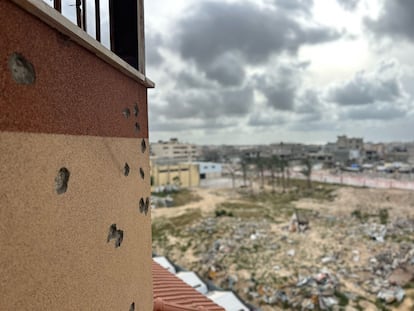
Spanish anesthesiologist Raúl Incertis, a volunteer with the small Canadian medical NGO Glia, works at the Al Nasser hospital. He uses a maritime simile to illustrate the situation he witnesses on a daily basis since arriving last Wednesday: “It’s like bailing out water from a boat full of holes.” Incertis recounts how one day of bombing triggered a mass casualty alarm twice. Between 35 and 40 patients arrived at once. “It’s not the first time I’ve treated bombed casualties, but it often happens here every day. The ICU is full and it’s like a house of horrors,” he says via video conference from the hospital.
Incertis still has the equipment for anesthesia (some children have been operated on without it in Gaza during the war), but is concerned about the shortage of supplies after a month and a half of the Israeli blockade of medical supplies. “At the rate we’re operating, I estimate that within a month we’ll notice shortages,” he explains. The center already implements cost-saving protocols: gloves are only replaced when they become soiled, intubation devices are cleaned, and when half of a drug is injected into a patient, the other half is used on another person who needs it, instead of throwing it away as is usually done.
The Hamas-led government’s Health Ministry in Gaza estimates that 37% of medicines and 59% of medical supplies are out of stock. Its data shows zero stock of 60% of what are considered essential items according to international standards. These include 99% of those used for cardiac catheters and open-heart surgeries; 87% for orthopedics; 45% for kidney and hemodialysis; and 42% for emergencies, surgery, and intensive care.
Key hospital departments also rely on power generators. Israel has cut off almost all electricity to Gaza since the early days of the war. A month ago, it disconnected the only line it had reconnected (the one supplying the water desalination plant) as part of its strategy to force Hamas to accept its terms by applying collective punishment to the entire population.
“Gaza’s health sector is being systematically dismantled”
The WHO representative for the West Bank and Gaza, Rik Peeperkorn, who spends several weeks in Gaza every two months to monitor the situation on the ground, addressed the United Nations Security Council last January via videoconference. He stated that functioning hospitals had a capacity “far below what is needed to deal with the overwhelming crisis situation:” 822 beds. “Gaza’s health sector is being systematically dismantled and pushed to its limits,” with hospitals “time and again turned into battlefields.” Most now provide only basic care due to a combination of “damage, attacks, and lack of resources,” he added.
Much of the medical care is thus shifted to health centers and so-called health points., which try to fill the gaps as best they can. More than half of the 145 of the former, and 360 of the latter, are no longer operating. It is, in a way, as if there were only emergencies, with doctors and nurses providing care without the ability to refer patients, because specialized care is practically nonexistent.
What would be serious in other contexts can be life-threatening in the Strip (where malnutrition is rampant and infectious diseases have skyrocketed). Polio reappeared in Gaza last August after a 25-year hiatus, necessitating an urgent vaccination campaign. Of the 130 babies born every day in Gaza (27% of them by Caesarean section), one-fifth are born prematurely, with complications, or underweight because their mothers were unable to obtain adequate nutrition during pregnancy.
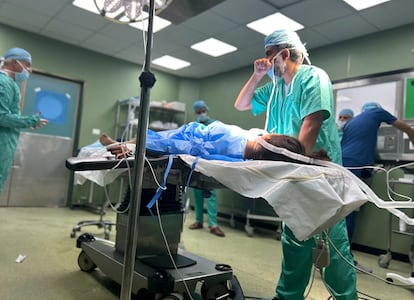
Since Hamas attacked Israel in October 2023, Israeli bombings have killed or wounded 7% (mostly children and women) of Gaza’s more than two million inhabitants. The Gaza Ministry of Health on Monday put the death toll at nearly 51,000 and the number of wounded at more than 116,000. A quarter of the latter suffer life-changing injuries, according to the United Nations.
One alternative would be medical evacuation, but it requires dwindling permits from the Israeli military authorities. Baby Mustafa Abu Freij, for example, has just arrived in Italy. His family had been waiting six months for authorization to treat him for the gunshot wound he suffered when he was nine days old. And he is just one of 4,500 children (out of a total of 12,000 people) who require urgent medical evacuation, according to the WHO. Coordinated medical evacuations have fallen short of actual needs since the beginning of the war, but only number a few dozen per month since May 2024, following Israel’s capture of the Gaza border crossing with Egypt. At the current rate, Peeperkorn estimated, evacuating those in need would take five to 10 years.
More than 1,000 health workers have been killed by Israeli attacks during the invasion of Gaza. The manner in which 15 died last month (on the deadliest single day of the war for Palestinian health services) sparked outrage outside the Middle East. They were killed (some with signs of execution) in three separate attacks on their ambulances; soldiers buried their bodies and covered the vehicles. A video recorded by one of the health workers before his death also revealed that the Israeli army lied in its initial account.
Sign up for our weekly newsletter to get more English-language news coverage from EL PAÍS USA Edition
Tu suscripción se está usando en otro dispositivo
¿Quieres añadir otro usuario a tu suscripción?
Si continúas leyendo en este dispositivo, no se podrá leer en el otro.
FlechaTu suscripción se está usando en otro dispositivo y solo puedes acceder a EL PAÍS desde un dispositivo a la vez.
Si quieres compartir tu cuenta, cambia tu suscripción a la modalidad Premium, así podrás añadir otro usuario. Cada uno accederá con su propia cuenta de email, lo que os permitirá personalizar vuestra experiencia en EL PAÍS.
¿Tienes una suscripción de empresa? Accede aquí para contratar más cuentas.
En el caso de no saber quién está usando tu cuenta, te recomendamos cambiar tu contraseña aquí.
Si decides continuar compartiendo tu cuenta, este mensaje se mostrará en tu dispositivo y en el de la otra persona que está usando tu cuenta de forma indefinida, afectando a tu experiencia de lectura. Puedes consultar aquí los términos y condiciones de la suscripción digital.
More information
Archived In
Últimas noticias
The metaverse, four years later: Is it finished or just at a standstill?
$3,000 and a plane ticket: The United States increases incentives for migrants to self-deport before the end of the year
Charles Dubouloz, mountaineering star, retires at 36 with a farewell tour inspired by Walter Bonatti
From the White House to diplomatic gifts: Lego wins over adult fans, brick by brick
Most viewed
- The low-cost creative revolution: How technology is making art accessible to everyone
- Families demand repatriation of bodies of Colombians who died in Ukraine: ‘This war is a slaughterhouse for foreigners’
- Christian Louboutin: ‘Young people don’t want to be like their parents. And if their parents wear sneakers, they’re going to look for something else’
- Christmas loses its festive spirit: ICE fears cast shadow over religious celebrations
- Liset Menéndez de la Prida, neuroscientist: ‘It’s not normal to constantly seek pleasure; it’s important to be bored, to be calm’

